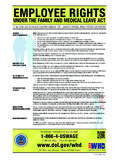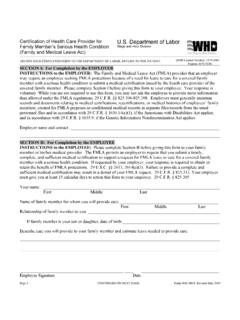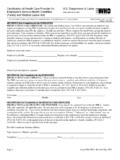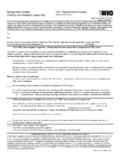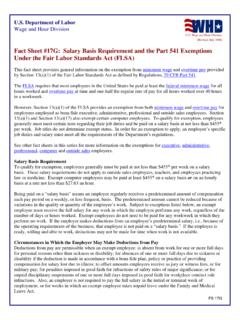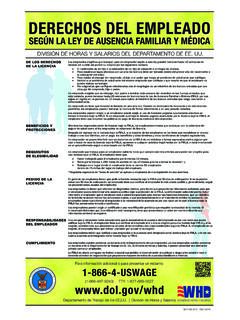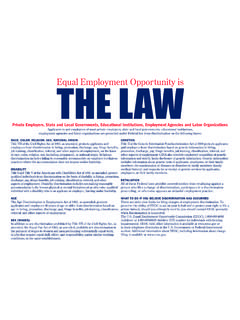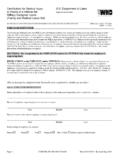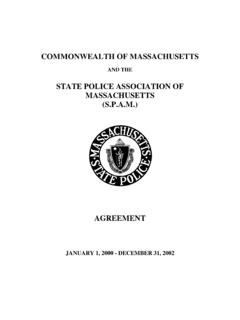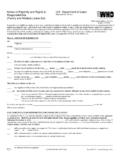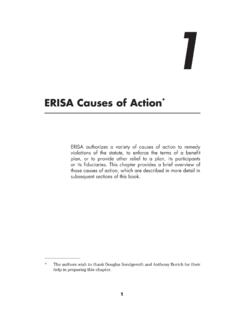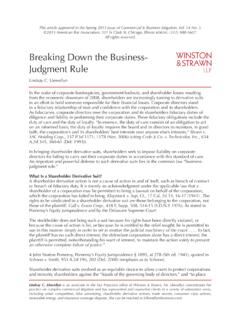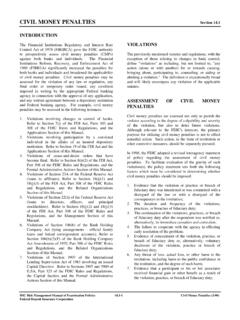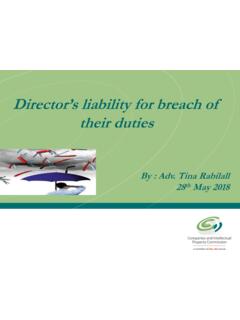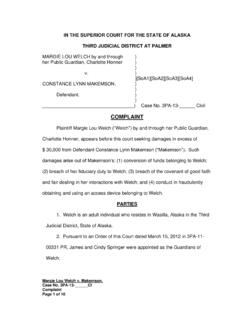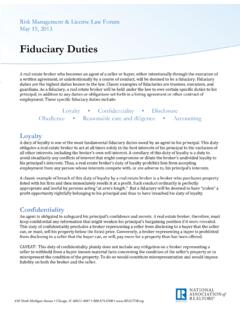Transcription of Meeting Your Fiduciary Responsibilities - DOL
1 Meeting Your Fiduciary ResponsibilitiesThis publication has been developed by the Department of Labor, Employee Benefits Security Administration (EBSA).To view this and other EBSA publications, visit the agency s order publications, or to speak with a benefits advisor, contact EBSA call toll-free: 1-866-444-3272 This material will be made available in alternative format to persons with disabilities upon request: Voice phone: (202) 693-8664 TTY: (202) 501-3911 This booklet constitutes a small entity compliance guide for purposes of the Small Business Regulatory Enforcement Fairness Act of Your Fiduciary ResponsibilitiesOffering a retirement plan can be one of the most challenging, yet rewarding, decisions an employer can make. The employees participating in the plan, their beneficiaries, and the employer benefit when a retirement plan is in place. Administering a plan and managing its assets, however, require certain actions and involve specific Responsibilities .
2 To meet their Responsibilities as plan sponsors, employers need to understand some basic rules, specifically the Employee Retirement Income Security Act (ERISA). ERISA sets standards of conduct for those who manage an employee benefit plan and its assets (called fiduciaries). Meeting Your Fiduciary Responsibilities provides an overview of the basic Fiduciary Responsibilities applicable to retirement plans under the law. This booklet addresses the scope of ERISA s protections for private-sector retirement plans (public-sector plans and plans sponsored by churches are not covered by ERISA). It provides a simplified explanation of the law and regulations. It is not a legal interpretation of ERISA, nor is it intended to be a substitute for the advice of a retirement plan professional. Also, the booklet does not cover those provisions of the Federal tax law related to retirement plans. What are the essential elements of a plan? Each plan has certain key elements.
3 These include: nA written plan that describes the benefit structure and guides day-to-day operations; nA trust fund to hold the plan s assets1; nA recordkeeping system to track the flow of monies going to and from the retirement plan; and nDocuments to provide plan information to employees participating in the plan and to the often hire outside professionals (sometimes called third-party service providers) or, if applicable, use an internal administrative committee or human resources department to manage some or all of a plan s day-to-day operations. Indeed, there may be one or a number of officials with discretion over the plan. These are the plan s fiduciaries. Who is a Fiduciary ?Many of the actions involved in operating a plan make the person or entity performing them a Fiduciary . Using discretion in administering and managing a plan or controlling the plan s assets makes that person a Fiduciary to the extent of that discretion or control. Providing investment advice for a fee also makes someone a Fiduciary .
4 Thus, Fiduciary status is based on the functions performed for the plan, not just a person s title. 1 If a plan is set up through an insurance contract, the contract does not need to be held in plan must have at least one Fiduciary (a person or entity) named in the written plan, or through a process described in the plan, as having control over the plan s operation. The named Fiduciary can be identified by office or by name. For some plans, it may be an administrative committee or a company s board of plan s fiduciaries will ordinarily include the trustee, investment advisers, all individuals exercising discretion in the administration of the plan, all members of a plan s administrative committee (if it has such a committee), and those who select committee officials. Attorneys, accountants, and actuaries generally are not fiduciaries when acting solely in their professional capacities. The key to determining whether an individual or an entity is a Fiduciary is whether they are exercising discretion or control over the number of decisions are not Fiduciary actions but rather are business decisions made by the employer.
5 For example, the decisions to establish a plan, to determine the benefit package, to include certain features in a plan, to amend a plan, and to terminate a plan are business decisions not governed by ERISA. When making these decisions, an employer is acting on behalf of its business, not the plan, and, therefore, is not a Fiduciary . However, when an employer (or someone hired by the employer) takes steps to implement these decisions, that person is acting on behalf of the plan and, in carrying out these actions, may be a is the significance of being a Fiduciary ?Fiduciaries have important Responsibilities and are subject to standards of conduct because they act on behalf of participants in a retirement plan and their beneficiaries. These Responsibilities include: nActing solely in the interest of plan participants and their beneficiaries and with the exclusive purpose of providing benefits to them; nCarrying out their duties prudently; nFollowing the plan documents (unless inconsistent with ERISA); nDiversifying plan investments; and nPaying only reasonable plan duty to act prudently is one of a Fiduciary s central Responsibilities under ERISA.
6 It requires expertise in a variety of areas, such as investments. Lacking that expertise, a Fiduciary will want to hire someone with that professional knowledge to carry out the investment and other functions. Prudence focuses on the process for making Fiduciary decisions. Therefore, it is wise to document decisions and the basis for those decisions. For instance, in hiring any plan service provider, a Fiduciary may want to survey a number of potential providers, asking for the same information and providing the same requirements. By doing so, a Fiduciary can document the process and make a meaningful comparison and the terms of the plan document is also an important responsibility. The document serves as the foundation for plan operations. Employers will want to be familiar with their plan document, especially when it is drawn up by a third-party service provider, and periodically review the document to make sure it remains current. For example, if a plan official named in the document changes, the plan document must be updated to reflect that another key Fiduciary duty helps to minimize the risk of large investment losses to the plan.
7 Fiduciaries should consider each plan investment as part of the plan s entire portfolio. Once again, fiduciaries will want to document their evaluation and investment decisions. Limiting LiabilityWith these Fiduciary Responsibilities , there is also potential liability. Fiduciaries who do not follow the basic standards of conduct may be personally liable to restore any losses to the plan, or to restore any profits made through improper use of the plan s assets resulting from their actions. However, fiduciaries can limit their liability in certain situations. One way fiduciaries can demonstrate that they have carried out their Responsibilities properly is by documenting the processes used to carry out their Fiduciary Responsibilities . There are other ways to reduce possible liability. Some plans, such as most 401(k) and profit sharing plans, can be set up to give the participants control over the investments in their accounts and limit a Fiduciary s liability for the investment decisions made by the participants.
8 For participants to have control, they must be given the opportunity to choose from a broad range of investment alternatives. Under Labor Department regulations, there must be at least three different investment options so that employees can diversify investments within an investment category, such as through a mutual fund, and diversify among the investment alternatives offered. In addition, participants must be given sufficient information to make informed decisions about the options offered under the plan. Participants also must be allowed to give investment instructions at least once a quarter, and perhaps more often if the investment option is volatile. Plans that automatically enroll employees can be set up to limit a Fiduciary s liability for any plan losses that are a result of automatically investing participant contributions in certain default investments. There are four types of investment alternatives for default investments as described in Labor Department regulations, and an initial notice and annual notice must be provided to participants.
9 Also, participants must have the opportunity to direct their investments to a broad range of other options, and be provided materials on these options to help them do so. (See Resources for further information.)However, while a Fiduciary may have relief from liability for the specific investment allocations made by participants or automatic investments, the Fiduciary retains the responsibility for selecting and monitoring the investment alternatives that are made available under the plan. A Fiduciary can also hire a service provider or providers to handle Fiduciary functions, setting up the agreement so that the person or entity then assumes liability for those functions selected. If an employer appoints an investment manager that is a bank, insurance company, or registered investment adviser, the employer is responsible for the selection of the manager, but is not liable for the individual investment decisions of that manager. However, an employer is required to monitor the manager periodically to assure that it is handling the plan s investments prudently and in accordance with the Plan FiduciariesA Fiduciary should be aware of others who serve as fiduciaries to the same plan, because all fiduciaries have potential liability for the actions of their co-fiduciaries.
10 For example, if a Fiduciary knowingly participates in another Fiduciary s breach of responsibility, conceals the breach , or does not act to correct it, that Fiduciary is liable as an additional protection for plans, those who handle plan funds or other plan property generally must be covered by a fidelity bond. A fidelity bond is a type of insurance that protects the plan against loss resulting from fraudulent or dishonest acts of those covered by the do these Responsibilities affect the operation of the plan?Even if employers hire third-party service providers or use internal administrative committees to manage the plan, there are still certain functions that can make an employer a Fiduciary . Employee ContributionsIf a plan provides for salary reductions from employees paychecks for contribution to the plan (such as in a 401(k) plan), then the employer must deposit the contributions in a timely manner. The law requires that participant contributions be deposited in the plan as soon as it is reasonably possible to segregate them from the company s assets, but no later than the 15th business day of the month following the payday.
